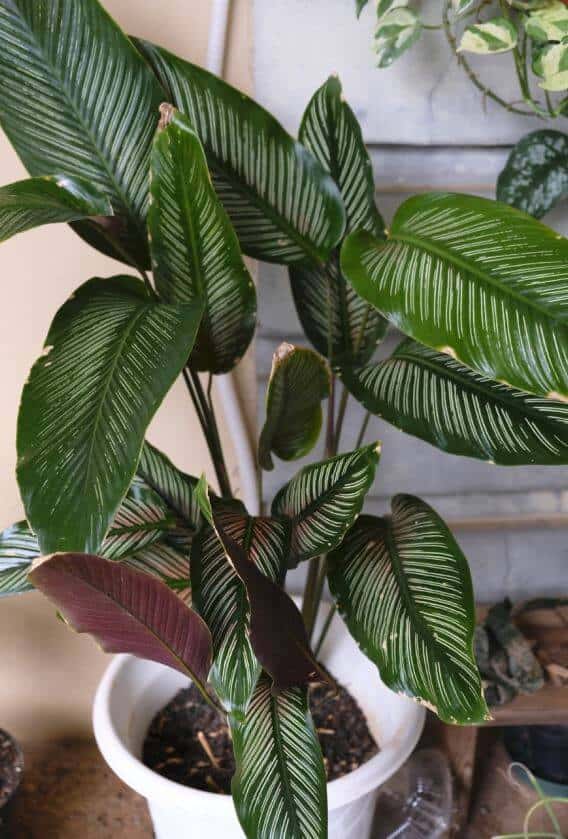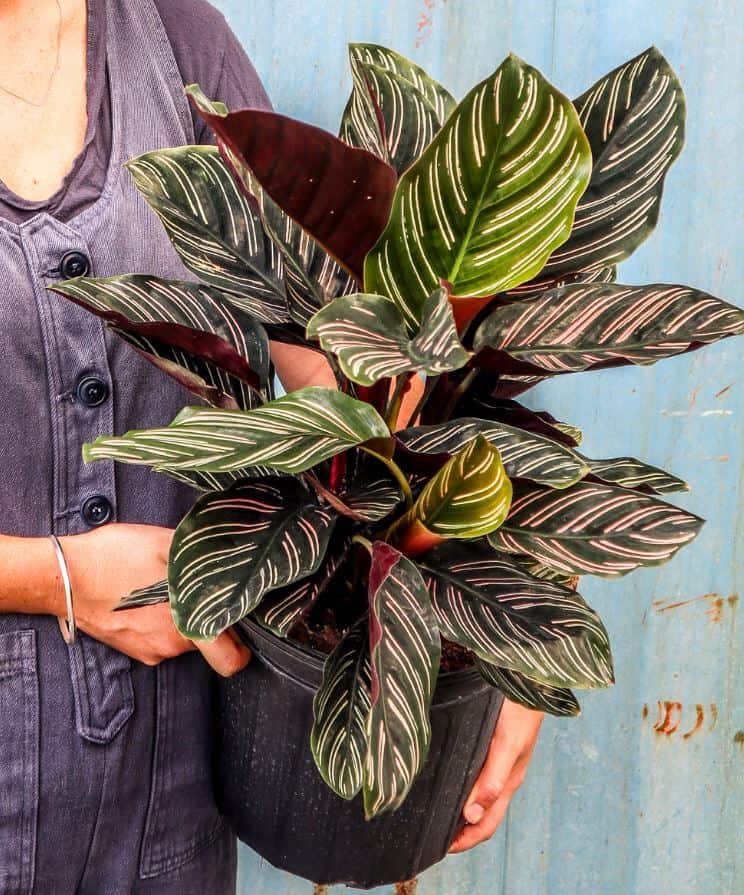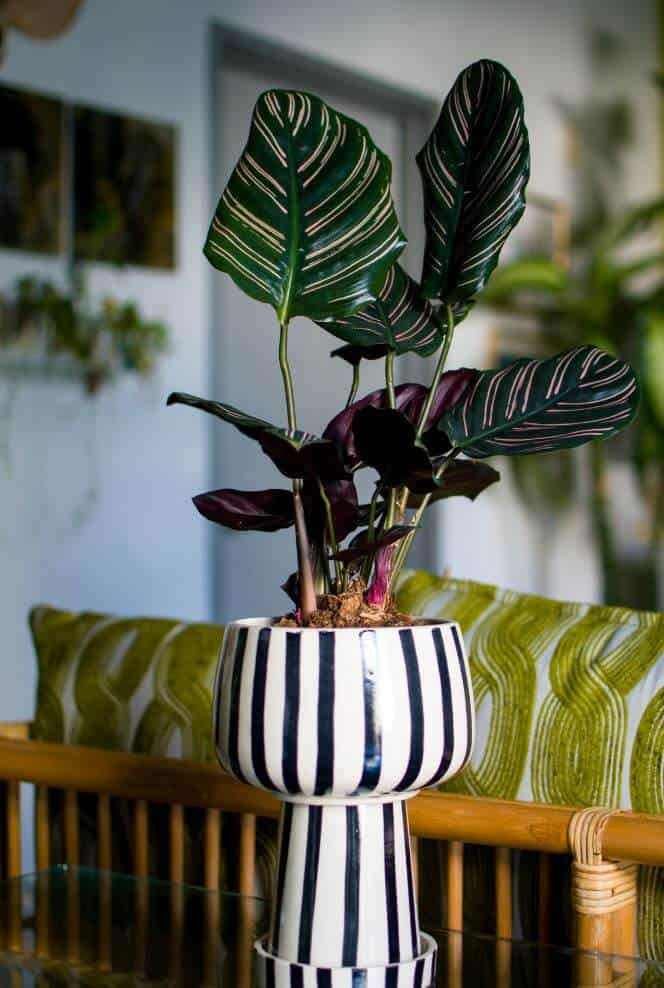Last Updated on March 26, 2023 by a Friendly Gardener
Beautifully veined foliage characterizes the striking Calathea ornata now scientifically referred to as the Goeppertia Ornata, and popularly known as the Pinstripe plant. Veining will appear silvery to pink and create a pinstripe pattern, hence its popular name. Belonging to the Marantaceae family, these houseplants are generically called Prayer plants.
These prayer plants can grow to heights and widths of approximately three feet and offer a stunning decorative accent wherever they are placed. Natives of Colombia can also be found in Venezuela, Thailand, Africa, Central, and South America as well as the West Indies as understory plants in forests and woodlands. Calathea species require a bit of extra care and can be tricky to keep happy and looking their best.
Pinstripe Plant Care

Dark deep green leaves appear on graceful thin stems and feature very pronounced veining. This perennial evergreen has a clumping growth habit that emerges from a rhizome. Known as a Prayer plant, the Pinstripe plant will close its foliage when the sun sets and reopen them at sunrise, mimicking the motion of two hands in prayer at nighttime.
Soil

A peat-based potting is best for indoor cultivation. You can select a potting mix formulated for African violets or blend a growing medium using one part perlite with two parts peat moss or try 2 parts potting soil with one part perlite and one part sphagnum moss or coco coir.
Calatheas need moisture and humidity to thrive. Soil should be maintained evenly moistened as Calatheas do not tolerate drought and will suffer when soil is left to dry. Still, if left to sit in soggy soil, your plant may develop root rot and will begin to wilt. Excellent drainage is a must so select a container with adequate drainage holes.
Light
While the Calathea ornata does best in bright indirect light it should not be exposed to direct sun rays as this can not only burn leaves but cause them to fade. This calathea likes a humid environment and can adapt to lower light conditions although it will do best in indirect light. If you cannot offer natural light near a windowsill, grow lights work just as well.
Water

Proper watering is fundamental to the successful cultivation of a Pinstripe plant however, the quality of the water is as well. Poor quality of the water you use can cause the tips of foliage to burn. Do not use water that has been filtered through a water softening system as this will be toxic to your plant as can hard water with too many minerals. Ideally, use collected rainwater or distilled water. If you have no other choice but to use tap water, allow the water to stand overnight to release additives through evaporation. If you underwater the Pinstripe Prayer plant, expect leaf edges to turn brown and crispy.
Humidity
High humidity levels are fundamental for keeping foliage in the best possible condition. If your indoor humidity levels tend to be low, increase humidity by using a space humidifier or place your Pinstripe plant above the water line on a pebble tray. Consider that a Pinstripe plant should have humidity levels measuring between 60% and 100%. Misting is a short-term solution that would need to be done daily to make a difference.
Temperature
As a tropical plant, the Pinstripe Prayer plant likes warmer temperatures that measure between 65° and 85° F. Temps should not drop below 60°F. and avoid exposing your Calathea ornata to cooler drafts.
Feeding
These houseplants are not heavy feeders. A Calathea ornata will benefit from fertilization with a quality liquid fertilizer that has been diluted during its growing season. Feeding should be interrupted during the winter season when growth slows.
Pruning
The Pinstripe plant does not require pruning. Trimming should be limited to the removal of dead or damaged foliage.
Repotting a Pinstripe Prayer Plant

Your plant grows from a principal rhizome and has a clumping growth habit so expect to see new shoots emerging often if your plant is healthy and happy. If there is substantial growth, you may decide to repot your plant into a larger container or divide the clumps and plant them in individual pots. The division will allow you to gift plants to friends and family while repotting the entire plant coupled with proper care may reward you with a spectacularly sized plant.
Pinstripe Plant Propagation

Stem cuttings are not used to propagate this houseplant. Plant division is the tried-and-true method for propagation. Remove your plant from its pot. You may notice individual clumps that have already formed. If not, using a sterilized garden knife, make a vertical cut directly through the rhizome. Each rhizome section or clump should have roots and some foliage attached.
Place each section in an individual pot with fresh growing medium and water. When new foliage appears, you’ll know that the new plants have adjusted.
Pinstripe Plant Problems
A fussy plant, the Pinstripe plant will communicate that it is unhappy. Fading stripes, crispy edges, or yellowing leaves are more indicative of an unhappy Calathea than of a dying plant.
These plants are relatively hardy but can suffer from both diseases and pest infestations. Spider mites are pests that like to suck sap from this plant’s foliage which then will die and drop. Place your plant under a shower to eliminate them and then treat your plant with Neem oil.
Crispy leaf edges are indicative of a lack of humidity, or of the quality of the water you are using. Tap water contains lots of minerals, and calatheas do not like fluoride, chloramine, and other chemical additives common to municipal water supplies.
Yellowing leaves may simply be due to normal aging, however overwatering, pest infestations, and too much sunlight exposition are also causes.
Pinstripe plant leaves curling indicates underwatering. Leaves will begin to curl inward to save moisture. However, overwatering can also lead to curling foliage. If the roots are unable to absorb nutrients because they are sitting in water, foliage may begin to curl.
Pinstripe Plant Toxicity
The Pinstripe plant is not toxic to humans or pets.

